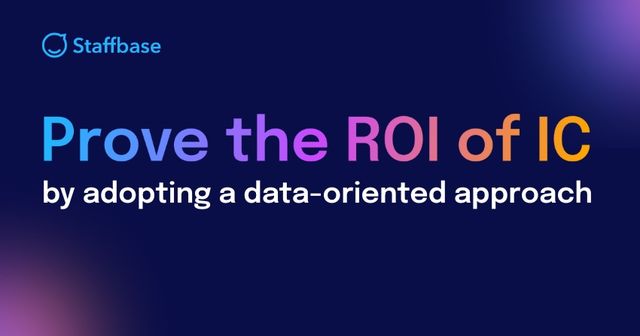5 easy steps to prove the benefit of internal comms to the C-suite
Want a seat at the table? These 5 steps will help you turn internal comms into a strategic business case your C-Suite can’t ignore.

As a professional communicator, you’ve navigated the choppy waters of the last few years. And you know how valuable internal comms is to your organization.
But proving your value to leadership? That’s where strategy meets storytelling. Here’s how to turn comms into a business case—with the data, alignment, and impact to win over your C-Suite. The best part? It takes just five steps.
1. Know who you need to influence (Hint: It’s not just the C-suite)
Before making your case to leadership, map out the key internal stakeholders who’ll shape their opinions. The four main teams you likely need to first get buy-in from are typically HR, IT, Finance, and Legal.
Each team has unique concerns. For example:
HR worries about retention, onboarding, and employee experience.
IT is focused on system consolidation, security, and minimizing resource drain.
Finance wants cost savings, productivity, and ROI.
Legal & Compliance cares about risk mitigation and communication continuity.
Create personas for each of them so you can better understand their needs, challenges, and goals. When you understand what each group values, you can tailor your case accordingly. This increases your chance of being heard.
2. Connect your comms strategy to business goals
Now that you’ve considered various personas, your communications strategy must show clear alignment with business priorities. So, your next step is demonstrating a concrete connection.
Rolling out a new employee app? Tie it to business outcomes: e.g., 80% app adoption by end of Q1 = increased engagement, better compliance, and faster crisis communication.
Launching a change campaign? Set KPIs that show how communications drive adoption, reduce resistance, and save time across departments.
And don’t stop at launch metrics. Build in a plan to track the ripple effects over time—like whether improved onboarding communications lead to faster ramp-up for new hires, or if consistent messaging during change initiatives results in fewer support tickets.
By mapping these outcomes directly to strategic priorities—such as retention, productivity, and operational efficiency—you show leadership that communications isn’t just a function that reports on results. It’s a driver that creates them.
3. Build executive relationships that help you win
While personas are great, nothing beats in-person conversations. Your next step is to schedule one-on-one conversations with leadership to gather insight and build strong rapport. Their perspective will strengthen your business case.
Ask questions like:
Where do you wish communication was stronger?
What’s the biggest roadblock slowing your team down right now?
If you could solve one communication challenge tomorrow, what would it be?
Where do you feel our employees are most in the dark?
What’s a recent win we should be talking about more internally?
Which upcoming changes do you think will need the most employee buy-in?
Where do you see misalignment between leadership’s message and employee perception?
These insights will help you position internal comms as a solution—not a side project. Think of it as audience research for your most important audience: decision-makers.
Your leadership team is the audience that you need to win over. And the more you know about their challenges and their vision, the more likely you are to rock your business case.
4. Back up your strategy with data
Next, make sure to measure the impact of your internal comms. Compile the data that’s most relevant to your business outcomes. Ditch the vanity metrics (opens, clicks) and show real impact. Think:
Alignment with key initiatives
Employee sentiment before and after a campaign
Reduction in time-to-read or support requests
Speed of adoption for new processes or technologies
Increase in participation for key programs or events
Change in employee trust scores over time
Reduction in errors or compliance incidents after targeted messaging
Improvement in cross-department collaboration metrics
Uplift in manager-led communication effectiveness
Retention rates among targeted employee groups
Use tools like Smart Impact to measure what matters—and translate those results into language leadership understands: efficiency, retention, cost savings. Advocate for the short, medium, and long-term investments your organization will need to make.
5. Show how new tech solves problems
Now it’s time to identify the benefits of the new IC technology. This is where it all comes together. With the right communications platform, you can:
Help HR reduce onboarding costs and improve employee retention.
Empower IT to consolidate tools and reduce maintenance burden.
Enable IC teams to streamline planning, publishing, and analysis across all channels.
Deliver enterprise-wide value with security, scalability, and measurable outcomes.
This isn’t just about adding another tool. It’s about solving real problems for multiple departments—while transforming internal comms into a business-critical function.
Ready to make your case?
When you connect the dots between communication and business impact, you don’t just earn buy-in—you earn a seat at the table.
Now that you have all these steps in mind, you’re better positioned to advocate for technology that will support your internal comms efforts and connect your employees no matter where they work. You’ll not only prove the value of internal comms to the C-suite—you’ll also make a compelling business case for IC.
Want to learn how the Staffbase platform can help you get there?


